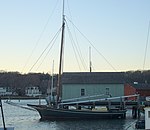Mystic River Bascule Bridge
Bascule bridges in the United StatesBridges completed in 1922Bridges in New London County, ConnecticutGroton, ConnecticutHistoric American Engineering Record in Connecticut ... and 2 more
Mystic, ConnecticutRoad bridges in Connecticut

The Mystic River Bascule Bridge is a bascule bridge spanning the Mystic River in Mystic, Connecticut in the United States. It carries vehicle and foot traffic directly into the tourist district of town via 33 ft-wide (10 m) Main Street (U.S. Route 1).
Excerpt from the Wikipedia article Mystic River Bascule Bridge (License: CC BY-SA 3.0, Authors, Images).Mystic River Bascule Bridge
Main Street,
Geographical coordinates (GPS) Address External links Nearby Places Show on map
Geographical coordinates (GPS)
| Latitude | Longitude |
|---|---|
| N 41.354722222222 ° | E -71.968611111111 ° |
Address
Mystic River Bascule Bridge
Main Street
06355
United States
Open on Google Maps








